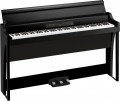Built-in timbres
The number of built-in sounds provided by the Digital Piano.
Despite the name, digital pianos are extremely rarely designed to imitate the sound of only a piano — the electronic hardware allows them to provide other timbres of sound. In addition, even the piano has its own varieties — for example, among the grand pianos there are 6 main classes, from large concert to miniature. So the built-in sounds can cover different kinds of pianos, as well as other instruments and sound effects.
The abundance and variety of timbres in digital pianos as a whole is not as great as in synthesizers, however, in this category there are very “charged” models, with a hundred timbres or more (in the most multifunctional, this number can exceed 900). However, it is worth specifically looking for a “multi-instrumental” model if you do not intend to be limited to the sound of the piano and would like to have more freedom of choice. It is worth remembering that a specific set of timbres can be different.
If the instrument is bought exclusively as a piano, then here, on the contrary, it is worth paying attention primarily to solutions with a small number of timbres. Such models are not only cheaper than "universals" — they can also sound better (due to the fact that there are few timbres and the manufacturer can carefully approach the sound quality of each built-in "instrument").
Outputs
—
USB to host (type B). Connector for connecting a digital piano to a computer using the USB standard; in this case, the instrument plays the role of a peripheral device. The possibilities of such a connection can be different: recording live music, updating firmware, voices and auto accompaniment styles, using the digital piano as an external MIDI keyboard, fine-tuning the instrument and troubleshooting, etc.; specific functionality varies from model to model.
—
MIDI out. An output that allows you to broadcast MIDI signals (MIDI events) from the Digital Piano to external devices. A MIDI signal is, in fact, a "preparation" of sound: a signal generated when a key is pressed and containing information about the note number, duration, and force of pressing. Based on this signal, the electronics of the instrument (or other device) generates the sound of a certain timbre. The MIDI output can be useful for connecting a digital piano to, for example, an external sequencer for recording, or to a synthesizer for playback in a tone that is not in the piano itself.
—
MIDI thru. Output used for switching MIDI signals. The description of such signals is given above, but here we note that the MIDI thru output duplicates the signals received at the MIDI input of the digital piano. This function can be useful in some specific cases — for example, connecting several electr
...onic instruments together.Built-in acoustics
The power of the native acoustics installed in the Digital Piano.
This indicator directly affects the maximum volume that the instrument is able to produce "on its own", without connecting external speakers. At the same time, it is worth noting that many manufacturers go to the trick and indicate in the characteristics not the rated power (rms power when operating at full volume), but the peak power, which is the highest power that the acoustics can deliver at short “ups” of volume. Peak power values can be quite impressive — in the tens and hundreds of watts — but these figures have a very indirect relation to the actual capabilities of the speakers. Therefore, before choosing, it is worth clarifying what kind of power is mentioned in the characteristics. To do this, it is not necessary to look for detailed data on the instrument, it is enough to compare the power of the speakers with the power consumption (see below): if the claimed power of the acoustics is greater than the power consumption of the entire instrument, then the manufacturer indicated exactly the peak value.
Number of bands
The number of bands provided in the Digital Piano's native acoustics.
In single-way acoustics, the speakers are responsible for reproducing the entire frequency range. Such systems are simple and inexpensive, but their amplitude-frequency response is far from perfect — most often they reproduce the mids well, but the bass turns out to be weak and unsaturated, the high frequencies are fuzzy and blurry. This is due to the fact that for each frequency there are separate requirements for the design of the speaker, and it is impossible to combine them in one speaker.
Thus, loudspeakers, including the built-in speakers of digital pianos, can be split into bands when the design provides for specialized speakers for a certain group of frequencies. The most advanced variant found in digital pianos is three-way, with separate sets of drivers for bass, mids, and treble. This allows you to achieve high-quality and reliable sound throughout the entire range, but complicates and increases the cost of the design. Therefore, three-way acoustics are rare, mainly in top-class instruments. But in mid-range instruments, two-way speakers are more often used (high frequencies on one set of speakers, medium plus low frequencies on the other).
Power consumption
The power consumed by the tool during normal operation.
The cost of electricity, as well as connection requirements, depend on this indicator. At the same time, we note that digital pianos require relatively little energy — even in the most powerful and advanced models, consumption usually does not exceed 60 watts. So in fact, power consumption data is required mainly for specific cases — for example, to calculate the total load when connecting a tool to an autonomous generator along with other devices. In addition, this information may be useful when assessing the power of the built-in speaker, for more information, see "Built-in acoustics".

